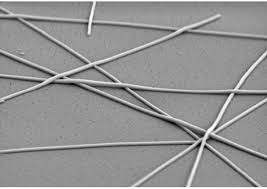Methods of replication and application (nano-wires) in the production of nano-microprocessors (bio chip) based on nano-micro electronics
Author and researcher: Afshin Rashid
Note: Nano-wires are used in the manufacture of computer nano-chips that use light to create high computational speeds rather than electricity.
Manufacture of nano-computer chips that use light to generate high computational speeds instead of electricity, in military cases - biologically detecting cancers and other complex diseases just by taking a single drop of blood, improving and refining smart cards and drones, and Nano military birds were used.
Another nanostructure that has received a lot of research and research today is nanowires. A wire is generally referred to as a structure that is extended in one direction (longitudinal) and very narrow in the other two directions . An essential feature of these structures, which have two outputs, is electrical conductivity. By applying a potential difference electric at both ends of the structure and charge transfer occurs along their length. Manufacturing nanometer-sized wires is both technologically and scientifically attractive, as nanometer-sized nanoparticles exhibit unusual properties .
Examples of nanowire applications include:
magnetic devices,
Chemical and biological sensors,
Biological markers and interconnections in nanoelectronics, such as the bonding of two pieces of aluminum superconductor made by silver nanowires .
Types of nanowires:
Metallic Nanowires: These nanostructures are promising because of their unique properties that are highly promising in electronic components. Metal nanowires are one of the most attractive materials because of their unique properties that lead to their various applications . Nanowires can be used on computers and other computing devices. To achieve sophisticated nanoscale electronic components, we need nanoscale wires. In addition, the nanowires themselves can also be the basis of electronic components such as memory.
The use of nano-wires in nano-biological processors
Organic Nanowires: These types of nanowires, as the name implies, are derived from organic compounds. In addition to metallic and semiconductor materials, nanowires can also be made from organic materials. Recently, a substance called "oligofeniline vinylline" has been introduced for this purpose. The characteristics of these wires (such as conductivity and resistance and thermal conductivity) depend on the monomer structure and its arrangement.
Conductor and semiconductor nanowires: The chemical structure of these compounds gives rise to interesting properties. The future of nanotechnology depends on the ability of researchers to master the molecular components techniques and nanomaterial structures. By imitating nature, they regulate the proteins from the yeast to produce conductor nanowires. Organizing living components in nature is the best and oldest example of "bottom up" manufacturing, so it can be used to understand and find ways to build electronic and micrometer devices. Until now, "top down" manufacturing techniques have been used, which are often laborious and cost-effective at the nanometer scale, and commercialization of nanotechnology requires easy and cost-effective methods that work best. The pattern is also the nature around us; we just have to open our eyes a little and look around us more closely. Silicon Nanowires: These types of nanowires are not toxic and do not damage cells. These types of nanowires have been widely used in the medical field, such as the detection of cancer symptoms, stem cell growth, and so on.
Application of nanowires for diagnosis: Nanowires made from materials used in modern computer chips such as silicon and gallium nitride can be used to diagnose diseases. You might ask what computer tools have to do with detecting the disease and the human body . Like a computer, the human body should have sensors that can alert external alarms in case of a problem or error or if there are any toxic substances. A computer that sends a message (ERROR) if you run the wrong path or find a virus. They produce flexible, long nanowires that range in length from 1 to 2 nm, or even millimeters, and are about a thousand times thinner than human hair in comparison. The size, flexibility and strength of these nanowires Adds special features to it. For example, being thin and stretchy increases its surface area. Therefore, these structures can be used in the design of very fast and sensitive sensors. These nanowires are capable of producing invisible ultraviolet radiation, light enters the nanowire from one end and glows from the other end. The nanowires effectively pass this light without any loss. And in its path, if it hits a pathogen or a toxic agent, the nanowire starts flickering and creates a very fast alert system that can detect the disease sooner and faster than any test.
Using nanowires in the blood vessels to stimulate the nerve: Always invent small transmitters into the veins and direct them to the desired locations of platinum nanowires that are 3 times thinner and thinner than human hair. They send these nanowires into the blood vessels and are guided to the nerve by a small camera. This method is very useful in helping to find different causes and emergence of neurological diseases, including Parkinson's. In the past, in order to find different causes of heart and nervous diseases, the body was broken anywhere to find the cause, but today with the development of nanotechnology technology every Devices can be invented, delicate, delicate and sensitive, and even transmitted to the finer vein.






